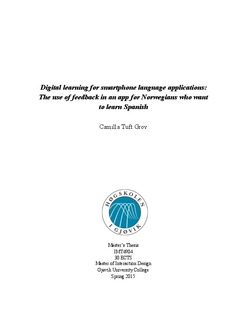Digital learning for smartphone language applications: The use of feedback in an app for Norwegians who want to learn Spanish
Master thesis
Permanent lenke
http://hdl.handle.net/11250/296523Utgivelsesdato
2015Metadata
Vis full innførselSamlinger
- Institutt for design [1054]
Sammendrag
There is an increased interest in digital learning and how technology creates new
possibility of combining and presenting different learning techniques. Feedback is a
learning technique in traditional learning usually received by submitting a draft or getting
a grade. However, digital learning creates space for students receiving feedback to learn
along the way while working towards another primary goal. By learning a second
language, such as Spanish in Norway, students are not exposed to the language in their
everyday life and it is therefore conceivable that they need more help in terms of
feedback for guidance. As a learning platform, smartphones give the opportunity for
ubiquitous learning, such that you are able to learn anywhere and anytime, and which
allows smartphones to be a good platform for language learning. The interaction
designer’s role is to design for a good user experience when learning and interacting
through using a user-centered development process. This study examines language
applications; digital learning with a focus on feedback and students needs and wishes for
learning Spanish. A survey, interviews and usability testing are used to investigate the
users’ needs, wishes for learning, motivation and test interaction with an app prototype
made based on theory and data presented in the thesis. State Of The Art shows that as
Spanish is one of the world’s most spoken languages (1), it is well represented on the
application market with apps such as Duolingo (2), SpeakTribe (3) and Busuu(4).
However, what we see is that there is a big variation in the quality of apps, especially
when the learner wants to learn from Norwegian to Spanish. Although research available
provides guidelines and techniques on how to use mobiles as learning tools, for example
by using mobile apps for fitting learning into students’ lives outside of classes and
providing digital quizzes (5-7), what can be see is that many existing apps have not
exploited the mobile platform nor taken into account basic design principles, such as
Nielsen’s usability heuristics (8), to design for a good user experience. Presented as the
conclusion is a prototype of a language learning application showing how interaction
with feedback can be used in digital learning, and developed by a user-centered design
process including State Of the Art and user involvement throughout the development.
